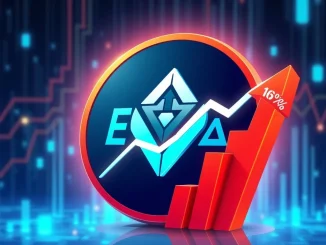
Exciting news for Ethereum enthusiasts and ETF investors! The crypto world is buzzing as the Securities and Exchange Commission (SEC) has officially acknowledged Grayscale’s filing to incorporate staking into its proposed spot Ethereum ETF. This development, initially reported by Unfolded on X, marks a significant milestone in the journey towards bringing staked ETH directly into traditional investment portfolios. But what does this really mean, and why is it such a big deal? Let’s dive into the details.
What’s Happening with the Spot Ethereum ETF and Staking?
For those new to the crypto ETF scene, a spot Ethereum ETF is a financial product designed to track the price of Ethereum. Unlike futures-based ETFs, a spot ETF directly holds actual Ethereum. Grayscale, a leading digital asset manager, is among the firms vying for SEC approval to launch such an ETF. Now, Grayscale isn’t just aiming for a standard spot ETF; they want to include Ethereum staking.
Ethereum staking is the process of participating in the network’s operations by locking up a certain amount of ETH to help validate transactions. In return for this service, stakers earn rewards, effectively generating passive income on their ETH holdings. Integrating staking into an ETF would mean that investors could potentially earn staking rewards through their ETF shares, making it a more attractive investment vehicle.
Why is SEC Review of Ethereum Staking in ETFs Significant?
The SEC’s acknowledgement of Grayscale’s filing is a pivotal moment because it indicates that the regulatory body is seriously considering the possibility of Ethereum staking within ETF structures. This is a notable shift, as the SEC has been cautious about crypto products, particularly spot ETFs. Here’s why this review is crucial:
- Validation of Crypto as an Asset Class: SEC review suggests increasing acceptance of crypto as a legitimate asset class within traditional finance.
- Potential for Increased Adoption: Staking in ETFs could attract more institutional and retail investors who are interested in earning yield on their crypto holdings without the complexities of direct staking.
- Market Maturation: Approval would signal further maturation of the crypto market, bringing it closer to mainstream financial integration.
Grayscale Leading the Charge: What Does This Mean for Investors?
Grayscale has been at the forefront of pushing for crypto ETFs. Their existing Bitcoin Trust (GBTC) conversion to a spot Bitcoin ETF was a landmark event. Now, they are attempting to replicate this success with Ethereum, and even innovate by adding staking. For investors, this could mean:
- Simplified Staking: Exposure to Ethereum staking rewards without needing to manage wallets, nodes, or understand complex staking mechanics.
- Tax Efficiency (Potentially): Investing through an ETF structure can sometimes offer tax advantages compared to direct crypto ownership and staking (consult your tax advisor).
- Accessibility: Spot Ethereum ETF with staking would be available through traditional brokerage accounts, making it accessible to a wider range of investors.
Challenges and Considerations for Spot Ethereum ETF Staking
While the SEC’s review is encouraging, several challenges and considerations remain:
- Regulatory Hurdles: SEC approval is not guaranteed. The regulatory landscape for crypto is still evolving, and the SEC might have concerns about staking, custody, and market manipulation.
- Staking Risks: Ethereum staking, while generally safe, does carry risks like slashing (penalties for validator misbehavior) and protocol vulnerabilities. How these risks will be managed within an ETF structure needs careful consideration.
- Operational Complexity: Implementing staking within an ETF adds operational complexity for fund managers like Grayscale, including managing validator nodes and reward distribution.
- Fee Structures: The inclusion of staking might impact ETF fees. Investors will need to weigh the staking rewards against the ETF’s expense ratio.
What are the Next Steps in Ethereum ETF Approval Process?
The SEC acknowledging the filing is just one step in a potentially lengthy approval process. Here’s what typically follows:
- Detailed Review: The SEC will conduct a thorough review of Grayscale’s filing, potentially requesting more information and clarifications.
- Public Comment Period: There might be a period for public comments, allowing industry participants and the public to voice their opinions.
- Decision (Approval or Rejection): Ultimately, the SEC will decide whether to approve or reject the Ethereum ETF staking proposal. This timeline is uncertain and can take months.
Actionable Insights: Staying Informed on Ethereum ETF Developments
For those interested in the potential of a spot Ethereum ETF with staking, staying informed is key:
- Follow SEC Filings: Keep an eye on the SEC’s website for updates on ETF filings and decisions.
- Monitor Crypto News Outlets: Stay updated with reputable crypto news sources like Unfolded and others for the latest developments.
- Understand ETF Mechanics: Educate yourself about how ETFs work, including fees, tracking error, and regulatory considerations.
- Consult Financial Advisors: Discuss with a financial advisor to understand if a spot Ethereum ETF with staking aligns with your investment goals and risk tolerance.
In Conclusion: A Promising Horizon for Ethereum and Crypto ETFs
The SEC’s review of Grayscale’s spot Ethereum ETF staking proposal is undoubtedly a positive development for the crypto industry. It signals a growing acceptance of crypto within traditional finance and opens up exciting possibilities for investors to access Ethereum staking yields in a simplified and regulated format. While the path to approval may still have hurdles, this step is a significant leap forward, potentially unlocking new avenues for crypto investment and mainstream adoption. Keep watching this space – the future of Ethereum ETFs is unfolding!



